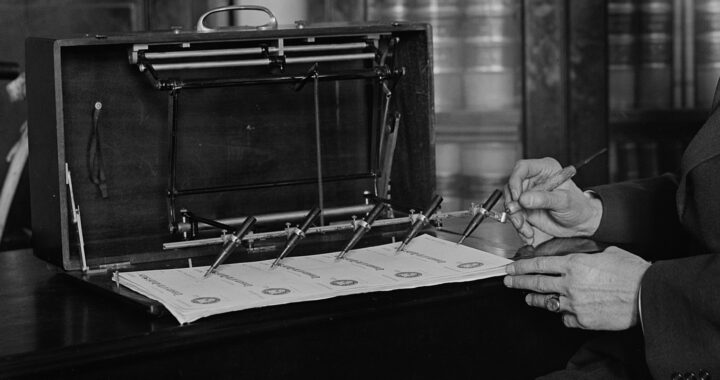Donald Trump declared that the presidential pardons made by former president Joe Biden as void and vacant because they were signed using an autopen or signing machine. He further contended that Biden did not know that he was signing such documents. The former U.S. president is known to extensively use an autopen to sign executive orders and official correspondence during his term. These arguments represent the more recent legal challenges to the use of autopen in affixing signatures in legal documents or the validity of documents signed using an autopen.
Defining Autopens and the Legal History of Signatures: A Challenge to the Legality of Signatures Executed Using an Autopen
What is an Autopen? How is it Used in the U.S. Government?
An autopen is a machine designed to reproduce the signature of a person. The actual signature is recorded and stored digitally. The mechanical arm of an autopen then replicates this signature onto documents. This is helpful in signing large volumes of documents quickly and efficiently. It is also particularly helpful for public figures, such as politicians, executives, and celebrities, who may need to sign numerous documents.
Former U.S. President George W. Bush refused to use an autopen during his term due to security and legal uncertainties. It was former U.S. President Barack Obama who officially adopted its use to sign legislative bills and other important documents. His first publicized use of an autopen was when he signed the extension of the Patriot Act in 2011 while traveling abroad. Biden made use of it throughout his presidential term.
Nevertheless, while the use of autopens is widely practiced, there is a relative lack of definitive legal rulings that precisely define its boundaries. Generally, the use of an autopen has been considered legally valid, especially when done under the direction and authorization of the individual whose signature is being replicated. The widespread usage of such instruments among officials highlights a legal gray area.
It is important to underscore the fact that Obama authorized the use of an autopen to sign the Patriot Act in 2011 while he was overseas. There were not contentions to this. Legal experts agree that this is valid because the President authorized it. The Department of Justice back then issued opinions stating and explaining that the use of an autopen for signing legislation is constitutional due to the presence of authorization.
What Constitutes a Signature? How Has Its Definition Evolved?
The traditional understanding of a signature often involves a handwritten mark that serves as personal identification and certification of the content of a document. This physical act of signing has long been a cornerstone of legal and commercial transactions because it provides a tangible evidence of the assent and commitment of an individual. Hence, for most transactions, handwritten signatures are the default requirement.
However, according to history, the common has demonstrated a degree of flexibility regarding the precise form a signature must take. The “principle of signatures” recognized early on that a signature could be legally valid even if affixed by an authorized agent or at the direction and in the presence of the signatory. This acknowledges that the essence of a signature lies in the intent to authenticate and the authority to do so.
Landmark cases such as Lord Lovelace’s Case in 1632 and the subsequent ruling by Chief Justice Holt in 1701 established that an individual could authorize another to sign on their behalf. This means that such a signature carries the same legal weight as one made by their own hand. This recognition of agency in signing documents forms a foundational element for considering the legality of modern mechanical signatures.
The court held in the 1905 Indiana case of Ardery v Smith that typed signatures affixed by an attorney under the supervision of a person physically unable to sign due to illness was valid. The English case Firstpost Homes Ltd v Johnson recognized non-handwritten signatures. These legal cases emphasized that non-handwritten signatures are legally acceptable when the intent and authorization of the signatory are evident.
What Could Be the Possible Legal Basis? What are the Contentions?
There are no specific law the directly addresses the use of autopens and their limitations. There are still several applicable laws and legal concepts. One of the most relevant ones is the principle of agency and the delegation of authority. This means that the use an autopen must be authorized by the principal to be valid. The authorization is made through a written documentation that grants usage and defines limitations.
It is also worth noting that the ability to sign documents can indeed be formally delegated within organizations. This delegation typically requires written documentation, specifies who can sign, and often prevents further sub-delegation. The specific legal bases for such include particular codes followed by different agencies and various statutory provisions and common law principles like the Uniform Commercial Code.
Others could argue that the Electronic Signatures in Global and National Commerce Act and the Uniform Electronic Transactions Act which provide a legal framework for digital signatures could support the use of autopens. However, these laws do not specifically address autopens, as they deal with electronic rather than mechanical replication. Some could still argue that autopens reproduce signatures from digital copies.
A critical factor in the legality of autopen use is the presence of clear authorization and intent. For example, it is used without the knowledge of an individual, or consent, it raises serious legal questions and also violates the elements of an enforceable contract or legal document. The question of if the person that the signature represents, was aware of the document being signed, is a very important part of its acceptable use.
